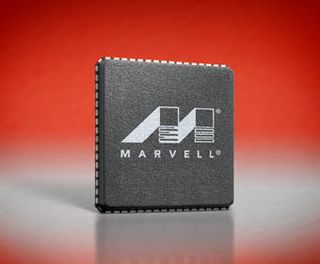Marvell rolls out Intel's next-gen Xscale processor
Santa Clara (CA) - It has been a long, and sometimes seemingly uncertain, way for the Monahans processor. More than a year after the CPUs first demonstration and almost half a year of Marvell's acquisition of Intel's applications and communications processor business, the new Xscale processor has finally arrived.
Intel's Xscale processors always have lived in the shadows of the company's larger Pentium, Xeon and Itanium processors. Despite their capable technology, first introduced in 2001, and some remarkable design wins, the public took little notice of these processors, which are integrated in a wide range of portable devices, for example RIM's Blackberry 8700c smartphone.
Intel's early and quite impressive demonstrations of the Monahans processor have sparked little excitement. Count in that Intel has provided few updates and virtually no information on Monahans since August of last year and it may not be surprising that there is quite some confusion what this product is about and perhaps little interest during the announcement of what in fact may be a very capable mobile CPU.
Monahans is the successor of the "Hermon" CPU (PXA901, used in the Blackberry 8700c), which integrates the "Bulverde" core (PXA270) that was announced in April 2004. Monahans will be available in three versions: It is shipping as PXA320 in volume now; the PXA310 and PXA300 will follow in the first half of 2007. Interestingly, the clock speed of the processor hasn't increased by much over time: While Bulverde is available with clock speeds of up to 624 MHz, the flagship PXA320 tops out at 624 MHz as well. According to its developer, the chip can scale up to 806 MHz, but even this mark is well below Intel's prediction from 2001 that Xscale would exceed 1 GHz within a few years.
There is much more potential in this processor - according to a presentation in August 2005 at least 1.25 GHz - but Marvell, which completed the $600 million acquisition of the Xscale processor business earlier this month, believes that there is simply no need for that kind of processing power in handheld devices today. For now and the near future, 624 MHz and perhaps 806 MHz in some high-end devices will be it.
In fact, other processor features may be much more important to help the chip to become more successful than its predecessor. Marvell claims that Monahans has made quite some progress in the areas of Multimedia capabilities, mobile Internet performance and battery consumption. Perhaps most significantly, the chip is able to run H.264 video, encoded at 3 Mb/s, at 30 frames per second and a resolution of 640 x 480 pixels (VGA). Other new features include the support of up to 5 megapixel digital cameras and, according to Marvell, and "hourglass free" web experience, which promises load webpages up to 50% faster than Hermon.

The Monahans processor
Stay on the Cutting Edge
Join the experts who read Tom's Hardware for the inside track on enthusiast PC tech news — and have for over 25 years. We'll send breaking news and in-depth reviews of CPUs, GPUs, AI, maker hardware and more straight to your inbox.
As its predecessor, Monahans is also capable of adjusting its clock speed between 104 MHz, 208 MHz, 416 MHz and 624 MHz, but apparently has received better fine-tuning in using the different clock speeds for specific applications: For example, playing MP3 files only requires 104 MHz, while loading webpages is accelerated at 624 MHz. All Monahans versions include Intel's Wireless MMX2 instruction set, but - similar to desktop and notebook processors - will differ on features such as cache. For example, only the PXA320 will integrate 256 kB L2 cache. Just like its predecessors, the third-generation Xscale processor is still based on a core that is based on 90 nm ARM technology.
We were somewhat surprised to hear that Monahans will not be available with a graphics companion chip. Compared to Bulverde, which was launched in combination with the 2700G multimedia accelerator chip, Monahans does not offer an external multimedia or graphics engine. We were quite certain that the new Xscale would offer a Shader Model 3.0 graphics engine after we had attended a briefing with Imagination Technologies earlier this year. Imagination delivers blueprints for graphics chips to a variety of companies and indicated that Intel may be using its PowerVR SGX technology for an Xscale graphics accelerator.
Marvell representatives declined to comment on possible agreements with Imagination, but explained that video features, including playback in VGA, are achieved through hardware acceleration provided by the Monahans core; 3D capabilities are currently only enabled through software.
While we haven't seen Monahans in a working product yet - and probably won't see a Monahans smartphone until Q1 2007 - the specifications let us believe that the new processor (which actually drops the Xscale name) is not a revolutionary new processor, but a solid update over the almost three-year old Bulverde chip. Improved features, especially battery time, may open the doors to more handset manufacturers, but the fact that Marvell is now manufacturing the processor could be even more important for the CPU's success.
Marvell, founded in 1995, has grown to more than 5000 employees and $2 billion in revenues with chip shipments that currently exceed 125 million every quarter, according to company officials. Compared to Intel, it has a greater focus on networks and has become a household name for networking products which could make it substantially easier for the company to market a product such as the PXA300 processor - which complements the firm's existing line of networking products such as Wi-Fi and UMTS chips. For the future, Marvell hopes that it can extend the CPU's reach from handheld computing devices and phones into areas such as digital cameras, home entertainment and enterprise networking.
Most Popular






